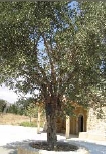|
|
 |
THE PREFECTURE OF RETHYMNO - INFORMATIONS
Access
Airports: Rethymnon is served
by the airports of Chania and Heraklion.
Port: There is direct connection all year round
from the port of Rethymnon to Piraeus.
Buses: Public buses can be used daily for
travelling to Chania, Heraklion, Siteia and to the most
of the townships and villages of the prefecture of
Rethymnon.
Highways: The main transport routes in the
province are a) the new national highway which runs
parallel with the north coast, b) the old national
highway, which is situated slightly south of the new
road, and c) Rethymnon - Spili - Agia Galini - Sfakia
road which runs north –south.
Natural Geography
Rethymnon stretches from the White
Mountains until Mount Psiloritis, bordered by the
provinces of Hania and Iraklion. It covers an area of
about 1.496 km2. The largest mountain ranges of the
White Mountains, Psiloritis and Kouloukounas and the
secondary ones of Kedros, Asiderotas and Vrisinas form a
network of valleys, the main one of which is Milopotamos
and the two valleys of Amari.
The few flat areas are found near the north and south
coasts, while the plateau of Nida stretches over the
mountainous mass of Psiloritis. The city of Rethymnon
with its 23,126 inhabitants is the capital of the
province. Smaller population centres are Anogia, Spili,
Perama and Episkopi. The villages of the province have a
small and constantly dwindling number of inhabitants,
which average about 180 persons.
Countryside and climate
Rethymnon is Crete's most mountainous
province. Of its 1.496 km2, 507 km2 are cultivated, 936
km2 are pasture, 36 km2 are covered by settlements and
only 17 km2 are covered by Mediterranean oak, pine and
maple-tree forest.
The climate is mild Mediterranean and particularly dry
and warm. There is sunshine 67% of the year and
temperatures range from 12°C to 27°C. The prevailing
winds are northerly and north-westerly, while occasional
hot southerly arrive from the African continent with
great strength.
While the environmental condition of the countryside is
relatively good, the centuries of farming and grazing
are beginning to take their toll. The quality of sea
water is still amongst the best in Europe. Many of the
mountains have been stripped due to overgrazing and
summer forest fires.
Of the eight types of the land of the province (plains,
semi-mountainous, sub-alpine, coastal, wetlands and
gorges) only in the last two has human presence not been
strongly felt.
The two most interesting gorges for wildlife are those
of Patsos and Prasses.

Main products of Crete:
-
Olive oil
-
Dairy products
-
Honey
-
Wine
Flora
The island is famous for its rich
flora; of the total number of plants, which flourish
throughout Europe, approximately 70% are found on Crete.
Thyme, oregano, savory, mint, dittany, chicory, sage,
marjoram and many other aromatic plants rich in protein
are characteristically found everywhere on the island.
Festivals
-
During the summer, since 1987,
the Municipality of Rethymno organises a
Renaissance Festival in the town of Rethymno. In
the Fortezza Theatre “Erophili”, visitors can enjoy
theatrical plays, music performances, exhibitions of
paintings, speeches, dancing performances,
pantomimes and film projections.
-
In the end of July a Wine
Festival is organised in the Municipal Garden of
Rethymno Town. Visitors can enjoy traditional Cretan
and Greek folklore music and dances. Wine is free
for everyone, giving the possibility to taste all
the varieties of the famous and excellent Cretan
wines.
-
"Vardinoyannia" meeting
was first held in 1985, and since then it is being
organized every year by the Athletic Club "Enosi
Atromitou Rethymniakou", under the auspices of the
Greek Sports Ministry and in cooperation with SEGAS.
The competitions took place in the new - Olympic
Standards - DAK Gallos Stadium "PAVLOS I.
VARDINOYANNIS" of Rethymno.
-
In the middle of August the
village of Anogia organises a Cultural Festival.
During this festival visitors have the possibility
to listen the magical sound of Lyra (traditional
lyre) and experience all kinds of cultural
activities.
-
In August the 15th the
celebration of the Holy Virgin is held with
religious ceremonies and great feasts with food,
wine and dances all around the prefecture of
Rethymno and in the entire island of Crete.
-
The feast day of the Holy
Cross celebrated on the 14th of September in the
village of Axos followed by a huge feast.
-
During the summer Municipality of
Kouloukonas organizes the Talaia festival.
-
The grandest Carnival of
Crete is organised in Rethymno Town and is one of
the most impressive of Greece, along with the one of
Patras (in Peloponnesus). On Shrove Thursday a
street party is organised and is the largest
open-air party of Crete with all kinds of music,
wine, appetizers and lot of fun. Another party is
organised on the Sunday before the great parade
during which the participating group are dressed up
and perform various sketches. The party includes
food, wine and dances until dawn. On Shrove Friday a
“rehearsal” of the big day takes place during which
all the participants present their masks and
carriages. When Shore Monday arrives, the entire
town becomes an explosion of colour and music;
everybody is masqueraded and sings, dances and
drinks all night long. During the same day, in the
picturesque mountainous villages of the prefecture
of Rethymno, old traditions and customs revive for a
magical and unique Carnival with games,
performances, happenings and satires.
-
On the 8th of November the
commemoration of the Arkadi Holocaust is taking
place in the entire prefecture and a religious
ceremony is held in the monastery of Arkadi where
locals bring flowers to the hundreds of Cretan who
died there in the 19th century in order to avoid
surrender to the Turks.
|



